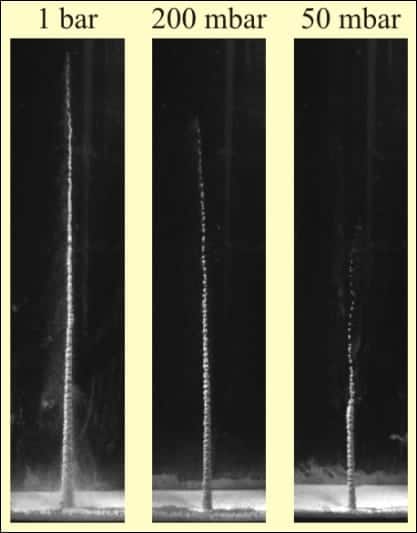The air between its grains makes sand act like a fluid, according to physicists in the Netherlands who have dropped balls into sand in order to simulate meteorite impacts. By doing their experiments in a partially evacuated chamber, the researchers discovered that the balls penetrated deeper into the sand and threw up more material at higher ambient pressures. The results shed new light on the relationship between granular systems and fluids (Phys. Rev. Lett. 99 018001).

Two years ago, Detlef Lohse and a team of physicists from the University of Twente devised a mechanism for crater formation by dropping metal balls in beds of sand. They found that the impact first throws sand outwards in a crown-shaped “splash”, leaving the ball to penetrate further into the surface and create a void. The pressure of the sand then forces the grains to fill the void, causing a vigorous jet of sand to shoot up from the centre (see related story: “Extraterrestrial impact created in the lab”).
The striking conclusion for the researchers was that this mechanism is very similar to what would happen in a liquid. This meant that, in certain circumstances, the well-established equations for fluid dynamics could potentially be used to describe poorly-understood granular systems such as sand. Now, however, Lohse and co-workers have gone one step further and found that the ambient pressure of the air above the sand is related to the height of the jet and the depth of penetration of the ball.
In a new set of experiments, they dropped 1.4 cm steel balls into a bed of sand 40 cm deep. But this time they put the entire apparatus inside a container that could be partially evacuated with an air pump, and attached a taut thread with markers to the balls so that the penetration depth could be read off easily.
With more air evacuated from the container, and hence less pressure, they discovered that the jet was less vigorous, and that the ball did not penetrate as deep. The researchers claim that this ties in with their existing mechanism: a lower pressure means there is less air surrounding the ball and the sand grains, thus increasing drag and making the sand behave less like a fluid. The net result is a shallower penetration, and a shorter jet. “It reveals the importance of air in fine granular matter,” Lohse told Physics Web.
Gabriel Caballero, a co-author of the study, said that the research could eventually have applications ranging from the design of space probes that have to land on other planets, to how powdered chemicals are mixed in pharmaceuticals. The team are now looking to investigate how the splash of the sand creates the ensuing crater.



